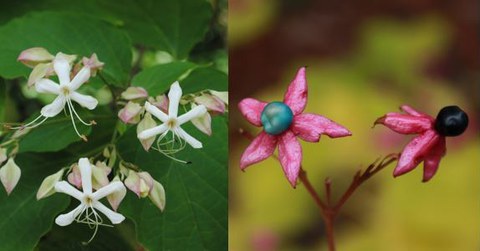Previous plants of the week - The harlequin glorybower
Clerodendrum trichotomum Thun.

At flowering time, the light green sepals with pale pink tips and edges are barely noticeable. In the fall, the sepals spread out in a star shape, contrasting in bright pink with the blue drupes and thus attracting fruit-eating birds.
Contrary to what its name suggests, the Harlequin glorybower usually grows as a loose shrub. White, sweet-scented flowers and remarkable fruits make this pioneer shrub attractive from summer to fall. It is native to forest edges and clearings in China, Korea, Taiwan and Japan. Our specimen originates from seed from the North Korean Diamond Mountains. Wild occurrences can be found locally in the USA, Great Britain, Italy, on the island of Java and in northern New Zealand.
Classified as a member of the Verbenaceae family until 1992, the genus Clerodendrum is now classified as a member of the Labiate family. Around 250 species mainly colonize the tropics and subtropics. Some of them can be seen in Rainforest House I. In front of its entrance in the tertiary area, the Harlequin glorybower is the hardiest representative, defying temperatures down to around -17 °C. The deciduous leaves are rich in essential oils and give off an unpleasant scent when rubbed.
Wood bees (Xylocopa) and diurnal and nocturnal moths pollinate the flowers, which grow in umbels up to 20 cm long: only insects with a long proboscis can reach the nectar hidden deep in the narrow corolla tube. When drinking, the relatively large insects touch the anthers or stigmas hanging out of the flower tube on long stamens or pistils. The stamens of the flower release their pollen first. Only hours later does the stigma open and absorb pollen. This "pre-masculinity" (proterandry) prevents self-pollination.
The five pale green sepals with a reddish tinge at the time of flowering become fleshy when the seeds are ripe, spread out in a star shape and turn bright pink. They currently underlay the initially turquoise-blue, later black-blue drupes with a very striking color contrast.
The healing properties of the decorative shrub are not visible from the outside: folk medicine in its native countries uses its leaves and young shoots, and more rarely the roots, flowers and fruits, to treat high blood pressure, arthritis and skin rashes, among other things. Current research is also investigating the effect of its ingredients against certain viruses and cancer cells.
(cw 44/24)
